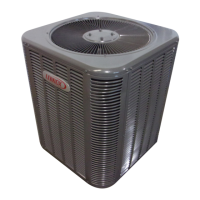Page 7
13ACX SERIES
If refrigerant lines are routed through a wall, seal and
isolate the opening so vibration is not transmitted to the
building. Pay close attention to line set isolation during
installation of any HVAC system. When properly isolated
from building structures (walls, ceilings. floors), the
refrigerant lines will not create unnecessary vibration and
subsequent sounds.
Also, consider the following when placing and installing a
high−efficiency air conditioner:
REFRIGERANT LINE SET
Field refrigerant line set consists of liquid and suction lines
from the outdoor unit to the indoor unit coil. Use Lennox
L15 (braze, non−flare) series line set, or field−fabricated
refrigerant lines that meet the specifications listed below.
Table 2. Refrigerant Line Set
Model
Valve Field
Connections
Recommended Line Set
Liquid
Line
Suction
Line
Liquid
Line
Suction
Line
L15 Line
Set
−018
−024
−030
3/8 in.
(10 mm)
3/4 in.
(19 mm)
3/8 in
(10 mm)
3/4 in.
(19 mm)
L15−41
15 ft. − 50 ft.
(4.6 m −
15 m)
−036
−042
−048
3/8 in.
(10 mm)
7/8 in.
(22 mm)
3/8 in.
(10 mm)
7/8in.
(22 mm)
L15−65
15 ft. − 50 ft.
(4.6 m −
15 m)
−060
3/8 in.
(10 mm)
1−1/8 in.
(29 mm)
3/8 in.
(10 mm)
1−1/8 in.
(29 mm)
Field
Fabricated
NOTE Some applications may required a field provided 7/8" to
1−1/8" adapter
NOTE − When installing refrigerant lines longer than 50
feet, contact Lennox Technical Support Product
Applications for assistance or Lennox piping manual. To
obtain the correct information from Lennox, be sure to
communicate the following points:
Model (13ACX) and size of unit (e.g. −060).
Line set diameters for the unit being installed as listed
in Table 2 and total length of installation.
Number of elbows and if there is a rise or drop of the
piping.
MATCHING WITH NEW OR EXISTING INDOOR COIL
AND LINE SET
The RFC1−metering line consisted of a small bore copper
line that ran from condenser to evaporator coil. Refrigerant
was metered into the evaporator by utilizing
temperature/pressure evaporation effects on refrigerant in
the small RFC line. The length and bore of the RFC line
corresponded to the size of cooling unit.
If the 13ACX is being used with either a new or existing
indoor coil which is equipped with a liquid line which served
as a metering device (RFCI), the liquid line must be
replaced prior to the installation of the 13ACX unit.
Typically a liquid line used to meter flow is 1/4" in diameter
and copper.
LIQUID LINE FILTER DRIER INSTALLATION
The filter drier (one is shipped with each 13ACX unit) must
be field installed in the liquid line between the outdoor unit’s
liquid line service valve and the indoor coil’s metering
device (fixed orifice or TXV) as illustrated in Figure 5. This
filter drier must be installed to ensure a clean,
moisture−free system. Failure to install the filter drier will
void the warranty. A replacement filter drier is available
from Lennox. See Brazing Connections on Page 9 for
special procedures on brazing filter drier connections to
the liquid line.
OUTDOOR
UNIT
LIQUID LINE
SERVICE VALVE
LIQUID LINE
FILTER DRIER
LINE
LIQUID
LINE
BRAZE CONNECTION
POINTS
Figure 5. Typical Liquid Line Filter Drier Installation
CAUTION
Brazing alloys and flux contain materials which are
hazardous to your health.
Avoid breathing vapors or fumes from brazing
operations. Perform operations only in well ventilated
areas.
Wear gloves and protective goggles or face shield to
protect against burns.
Wash hands with soap and water after handling brazing
alloys and flux.
IMPORTANT
The Environmental Protection Agency (EPA) prohibits
the intentional venting of HFC refrigerants during
maintenance, service, repair and disposal of appliance.
Approved methods of recovery, recycling or reclaiming
must be followed.
IMPORTANT
If this unit is being matched with an approved line set
or indoor unit coil which was previously charged with
mineral oil, or if it is being matched with a coil which
was manufactured before January of 1999, the coil
and line set must be flushed prior to installation. Take
care to empty all existing traps. Polyol ester (POE) oils
are used in Lennox units charged with HFC−410A
refrigerant. Residual mineral oil can act as an
insulator, preventing proper heat transfer. It can also
clog the expansion device, and reduce the system
performance and capacity.
Failure to properly flush the system per the
instructions below will void the warranty.

